Beloved 150-year-old banyan tree in Lahiania starts to show signs of new growth following the devastating Maui wildfires that killed 97
Hawaii’s legendary 150-year-old banyan tree has begun to show signs of life after suffering enormous damage from the catastrophic wildfires on Maui that left 97 people dead.
Known as the “Heartbeat of Lahania,” the tree was completely scorched by the Aug. 8 fire and initially showed no signs of returning to its original state.
Recently, the Hawaii Department of Land and Natural Resources said the tree’s multiple trunks had begun to recover.
Several volunteers brought in water trucks to douse it with hundreds of gallons of water every few hours after the damage. Maui arborists, landscapers and volunteers formed a hui to care for the tree.
The ministry confirmed the appearance of new leaves on the trunks and branches. Signs of new life indicate positive signs for the tree’s long-term recovery.
Steve Nimz of Tree Solutions Hawaii found “no significant signs of burning, charring or cracking on the main trunk or most of its more than 40 aerial roots,” according to the Honolulu Star-Advertiser.
The Hawaii Department of Land and Natural Resources said the tree’s multiple trunks have begun to recover.
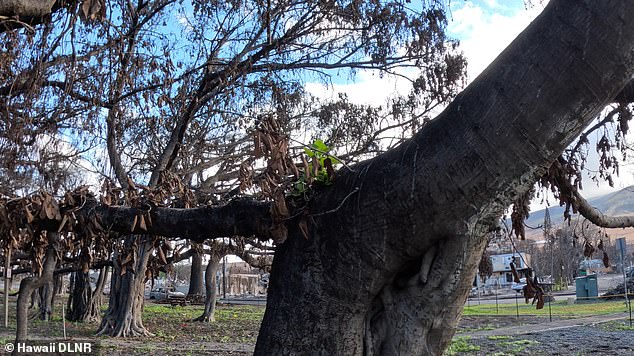
Steve Nimz of Tree Solutions Hawaii found “no significant signs of burning, charring or cracking on the main trunk or most of its more than 40 aerial roots.”
He also found “living tissue in the cambium of the tree beneath the layer of bark” and discovered that the soil beneath the tree had not been affected.
The tree was fed with compost tea, which is a mixture of natural ingredients injected into the soil around the circumference of the base. Volunteers also cut small blocks of alfalfa, a legume, and spread them on the ground to see if the nutrients would help the tree.
Landscape Contractor Chris Imonti explain: ‘We did some root sampling last week and had some really good news regarding new life in the roots. Lots of new roots sprouting.
“We tested the humidity and arborist Steve Nimz, who is the unofficial leader of the Banyan Tree, analyzed all the treatments and is now installing sensors on the tree to measure the rates growth.”
“With compost tea we are getting good results and as long as we give it enough love I think we will be fine.”
The Lahaina Banyan Tree, located near the city’s historic courthouse, is known as the oldest living banyan tree in the United States.
The tree was imported from India and planted in front of the courthouse in 1873 at just 8 feet tall.
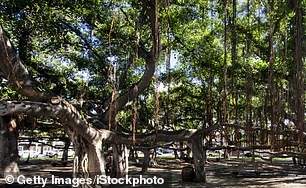
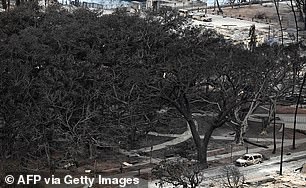
The 150-year-old Lahaina tree stands more than 60 feet tall and covers nearly two acres of land near the courthouse. After the August 8 fire, it was severely damaged and is not expected to fully recover.
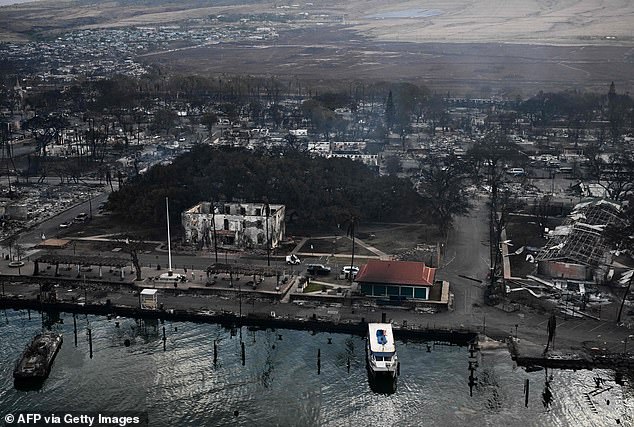
The historic tree remained standing amid the carnage but appeared badly burned following the West Maui wildfires.
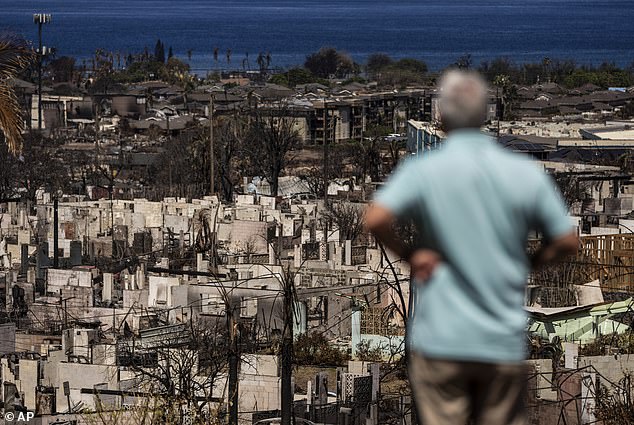
More than 3,000 people have signed up for federal aid, according to the Federal Emergency Management Agency and expect that number to rise.
The tree now stands more than 60 feet tall with 47 main trunks and spans nearly two acres, according to the city of Lahaina website.
The tree is a member of the fig family and its aerial roots drape toward the ground, allowing the tree to grow vertically and horizontally.
It is also home to hundreds of mynah birds, introduced to Hawaii in 1865 to combat army worms.
The banyan tree holds a special place in the Lahanian community and served as a place for festivals and proposals before its devastation. The Lahania Banyan Tree has also hosted countless holiday celebrations, hula and craft fairs. In April 20234, the Lahaina Restoration Foundation held a celebration of the tree’s 150th anniversary.
The wildfires have resulted in the deaths of at least 97 people and the displacement of 11,000 people.
Maui County officials alleged in a lawsuit that Hawaiian Electric’s “intentional and malicious” mismanagement of power lines allowed flames to ignite, causing the fire to spread.
The fire that ravaged Lahaina, a centuries-old town, destroyed almost every building in the town of 13,000 people.
About 86 percent of the approximately 2,200 ruined buildings were residential, and the value of the destroyed property was estimated at more than $5 billion.
Even where the fire has retreated, authorities have warned residents that toxic byproducts could linger, including in drinking water, after the flames released toxic vapors. This prevented hundreds of people from returning home.
More than 3,000 people have signed up for federal aid, according to the Federal Emergency Management Agency and expect that number to rise.
Hawaiian Electric Co. Inc. will cooperate with the state’s investigation and conduct its own, President and CEO Shelee Kimura said.
Kimura said many factors go into the decision to cut power, including the impact on people who rely on specialized medical equipment. She also noted that cutting off power to the fire zone would have knocked out water pumps.
